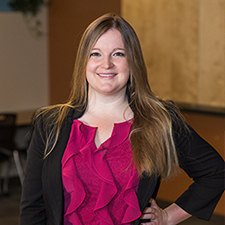 -by Laurie Burns
-by Laurie Burns
community collaborations and impact analyst
It probably comes as no surprise to anyone that a key factor of completing any postsecondary credential is finding a solution for the financial burden that comes with pursuing a degree or certification. Scholarships, like the $1.2 million awarded through Central Indiana Community Foundation (CICF), play a major role in supporting students’ financial success. One of the main tenets of CICF’s awarding philosophy is to provide or leverage financial resources to help cover at least 80 percent of the cost of attendance for students at their chosen institution.
In May of this year, the Federal Reserve released data showing that student loan debt has reached over $1.5 trillion dollars.
While an ideal scenario would be to cover 100 percent of a student’s cost to attend school, there is just not enough funding to go around to all qualified applicants. Therefore, the hope is that if we cover at least 80 percent, then the last 20 percent can be earned through work-study or the student can utilize minimal student loans. However, as CICF embarks on a journey to deepen our impact in the community and truly provide an equitable opportunity for all individuals, no matter their place, race or identity, it is important to examine if our “at least 80 percent” philosophy is still good enough.
Search the internet for “student loans” and you will find countless articles discussing the growing student loan debt and its impact on students. In May of this year, the Federal Reserve released data showing that student loan debt has reached over $1.5 trillion dollars—more than double the student loan debt amount from 10 years ago. In Indiana, students attending public universities graduate with an average student loan debt ranging between $22,000 – $29,000, and students attending private universities graduate with debt averaging between $22,000 – $59,000.
At CICF, we are proud that a majority of our scholars complete their education, but what kind of future are we providing our scholars if they are saddled with student loan debt after graduation?
While investing in your education is a reasonable argument for taking out student loans, the statistic that gave me pause was that last year, 20 percent of individuals with education debt are behind on their payments, according to the Federal Reserve. And those with the highest risk of falling behind are students that do not complete their degree. Research also shows that if we look at the demographics, the individuals with a higher risk of falling behind on payments are first generation students and students of color. That is concerning for CICF because that same demographic makes up a significant portion of CICF scholarship recipients.
Currently, CICF has over 300 scholarship recipients attending schools across the country; 42 percent of our scholarships are awarded to first generation students and a majority of scholarships to students of color. I expect those numbers will increase as we get better at promoting our scholarships and design a more effective application process—but we have to make certain that we are awarding our scholarships in a way that best enables the student to be successful in school and after.
At CICF, we are proud that a majority of our scholars complete their education, but what kind of future are we providing our scholars if they are saddled with student loan debt after graduation? In a revised report from the Center for Retirement Research, the authors found that individuals holding a bachelor degree and student loans, regardless of the size of the loan, have significantly lower retirement assets by the age of 30 than individuals without student loans. Another study posits that increases in student loan debt has a negative impact on home ownership in the first five years after finishing school. And still more articles and reports argue additional negative consequences of student loan debt. So while CICF tries to minimize the student loan amount for our scholars, there could still be negative consequences for our scholarship recipients, and that’s something we’re working on addressing.
CICF would like to provide or leverage more than 80 percent of the financial cost for students, but like the rest of our new mission, we cannot do it alone. Thankfully, in Indiana, there are many institutions and organizations working to improve the completion rate for all students, and we work closely with those partners to elevate our students’ academic and financial success.
If we all want to ensure that the next cohort of degree seekers has the opportunity to succeed in their education and beyond, all of us in this community need to come together to support these individuals.
Learn about opening a scholarship fund here.
Learn how to apply for a scholarship here.






Leave A Comment